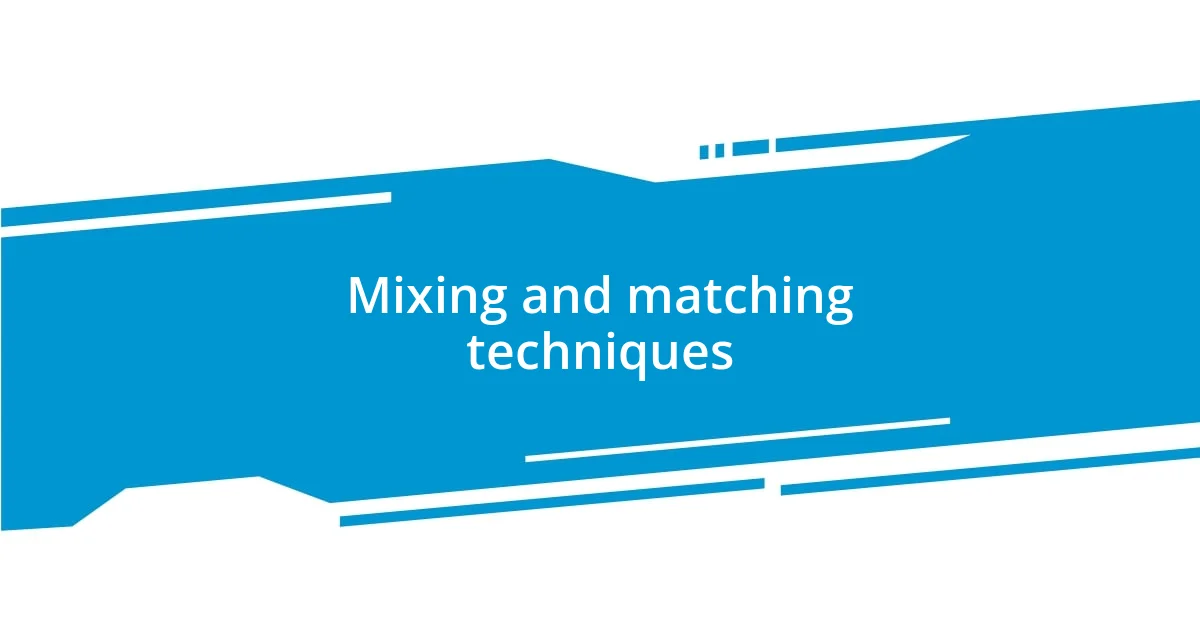Key takeaways:
- Understanding patterns and textures influences emotions and personal style in design, affecting areas like fashion, interior decor, and graphic design.
- Color harmony is crucial for creating a cohesive visual experience, impacting emotional responses, visual appeal, and even brand recognition.
- Thoughtfully selecting patterns for different spaces can enhance functionality and mood, with techniques like mixing scales and layering textures to create inviting environments.

Understanding patterns and textures
Patterns and textures play a crucial role in the overall aesthetic of design, whether it’s in fashion, interior decor, or graphic design. I remember the first time I experimented with combining different fabrics in a DIY project; the way the roughness of burlap complemented the softness of satin was a revelation. Can you imagine how striking a room can feel when your eye dances across contrasting patterns?
When I think about textures, I often reflect on how they evoke emotions. For instance, the smoothness of ceramic pottery can instill a sense of calm, while the chaotic splatters of an abstract painting can ignite energy in a space. Have you ever noticed how a textured wall can completely shift the vibe of a room? It’s intriguing how the tactile quality of materials influences our feelings, doesn’t it?
Moreover, understanding the nuances of patterns—like geometric versus organic shapes—can dramatically influence our choices. I personally gravitate toward geometric patterns for a clean, modern look, while floral designs stir a sense of nostalgia for me. What does your choice of patterns say about you? Just as I’ve discovered, they can reveal our personality and even our stories, making them a fascinating subject to explore.

Importance of color harmony
Color harmony holds immense significance in design because it creates a cohesive and balanced visual experience. I vividly recall the frustration I felt when I mismatched colors in a home project, resulting in a disjointed look that just didn’t resonate. It’s amazing how color can tie different elements together, transforming a chaotic scene into something harmonious and inviting.
Here are key reasons why color harmony matters:
- Emotional Impact: Harmonious colors can evoke positive feelings and create a desired atmosphere, like a serene blue that calms or a vibrant yellow that energizes.
- Visual Appeal: When colors complement each other, they create an inviting space, making it more enjoyable for you and your guests.
- Focus and Flow: A well-thought-out color palette guides the eye smoothly across a space, making it easier to appreciate the various patterns and textures at play.
- Identity and Brand Recognition: In marketing, color harmony plays a crucial role in brand identity, influencing how customers perceive the brand and their likelihood to engage.
In my own experience, curating a color scheme for my living room was a delightful journey. I replaced my clashing décor with a palette of muted greens and earthy browns, crafting a space that felt both grounded and warm. The result? A room that not only reflects my personality but also invites comfort and relaxation, showing just how pivotal color harmony is in design choices.

Choosing patterns for different spaces
Choosing patterns for different spaces requires a thoughtful approach to harmonize the functionality and aesthetic of each area. In my own home office, I opted for a subtle pinstripe on the walls, which helped create an environment of focus and clarity. It’s fascinating how a well-chosen pattern can subtly influence productivity, isn’t it? In contrast, I like to employ more vibrant, playful patterns in spaces meant for relaxation, like my living room, where a bold tropical print can spark joy and inspire creativity among guests.
When it comes to choosing patterns for a bedroom, I lean toward softer, more tranquil designs. I can vividly recall the peace that washed over me when I switched out a loud geometric duvet cover for a calming botanical print. The floral patterns provided a sense of serenity, making it the perfect retreat at the end of a long day. Have you ever wondered how patterns in your sleeping environment affect your rest? I believe they can play a substantial role in setting that calming atmosphere, enhancing sleep quality.
Finally, there’s the dining area, where I often play with prints to foster energy during gatherings. I once chose a tablecloth adorned with vibrant paisley, which not only sparked conversation but also brought warmth to the shared meals. Such patterns can convey a sense of hospitality, inviting guests to enjoy the atmosphere around them. It’s intriguing how the right choice transforms an ordinary dining experience into something memorable, don’t you think?
| Space | Recommended Patterns |
|---|---|
| Home Office | Subtle stripes or solid colors for focus |
| Bedroom | Soft florals or calming designs for relaxation |
| Dining Area | Bold prints or warm patterns to invite conversation |

Mixing and matching techniques
Mixing and matching techniques can be both exciting and daunting, but I find that a little experimentation goes a long way. For instance, I once chose to combine a floral wallpaper with geometric throw pillows. At first, I was nervous about the clash, but to my surprise, the combination created a whimsical yet balanced aesthetic that truly reflected my personality. Have you ever felt that thrilling moment of stepping outside your comfort zone? It’s magical when things come together unexpectedly.
One effective technique I often use is varying the scale of patterns. By pairing a large-scale print with smaller patterns, I ensure a sense of balance and visual interest. I vividly remember when I decorated my entryway; I mixed a bold, oversized checkered rug with delicate striped accessories. This dynamic pairing made the space feel inviting without overwhelming the senses. It’s like creating a conversation—it’s important to have different voices contributing to the dialogue.
Textures also play a crucial role in mixing and matching. I have a soft spot for using contrasting materials to enhance depth within a design. Picture this: a cozy knit blanket draped over a sleek leather chair. The combination sparks warmth while maintaining an elegant touch. How do the textures in your space make you feel? For me, it’s the tactile experiences that forge a personal connection, making my home a true reflection of who I am.

Assessing texture for comfort
When I assess texture for comfort, I often think about how each material feels against my skin and the emotional response it evokes. For instance, I once chose a plush velvet for my living room sofa—not just for its luxurious appearance but because it invites me to sink in and relax. Have you ever noticed how certain fabrics can instantly make you feel at home? The gentle touch of texture can wrap you in a warm embrace or leave you feeling oddly detached.
I’ve learned that layering textures is instrumental in creating a sense of coziness. A memorable moment for me was when I complimented a smooth, tight-weave cotton throw with a cozy, oversized knitted blanket. The contrast was delightful, each layer adding depth to my space while enhancing the overall comfort. It’s a simple, yet effective approach that elevates a room from basic to inviting—how do your favorite textures interact in your home?
Another aspect I evaluate is the durability of textures, particularly in high-traffic areas. I once had a stunning, delicate linen runner on my dining table, but it didn’t hold up well during family gatherings. Switching to a more resilient, textured fabric that still felt soft made a world of difference. I think back to that transition and realize how essential it is to find that balance between comfort and practicality; otherwise, it can disrupt the joy of gathering around the table. Don’t you agree that functional comfort makes a space truly livable?

Creating focal points with patterns
Creating focal points with patterns can truly transform a space. I recall a particular moment when I used a vibrant, abstract print as a statement piece above a fireplace. The artwork not only drew the eye but also set the emotional tone of the entire room. Have you ever noticed how a single piece can dominate your attention and establish a mood?
To enhance that focal point, I paired the artwork with more subdued patterns elsewhere in the room. This allowed the bold print to shine without competition. It’s like orchestrating a symphony; every element has a role, and everything else must support the lead. I find it so rewarding when a room begins to harmonize. How do you decide what stands out in your space?
I also love to think about the stories behind the patterns I use. One time, I discovered a collection of handcrafted ceramic tiles during a trip—each piece unique and bursting with color. Incorporating them as a backsplash in my kitchen created not just a focal point but also a personal connection to my travels. It’s fascinating to see how patterns can evoke memories and feelings, isn’t it? When a space resonates with our personal narrative, it truly becomes a reflection of who we are.

Finalizing your design choices
Finalizing my design choices often comes down to a balancing act between personal preferences and practical considerations. I vividly remember a time when I was torn between a bold geometric wallpaper and a soft, natural-toned paint for my office. Ultimately, I opted for the paint to create a serene environment, and I layered in the quirky geometric accents with decor. It taught me that sometimes, less can truly be more; how do you find harmony in your spaces?
As I finalize my decisions, I also pay attention to how the chosen patterns and textures will change with lighting throughout the day. I once had a beautiful, intricate fabric that looked stunning in the store but felt overwhelmingly dark in my bright living room. I had to remind myself that light brings color to life, and I switched to a lighter, airy fabric that danced gracefully with the sun. Have you ever experienced that shift in perspective when you see a color in the natural light?
Finally, the emotional resonance of my choices often guides my final selections. I recently curated a cozy reading nook filled with soft, inviting textures, reflecting my love for quiet moments with a good book. The warm throw and plush cushion serve as a gentle reminder to pause and savor the present. How do your design elements evoke feelings in your space? After all, a well-curated environment can enrich our lives in the most unexpected ways.















